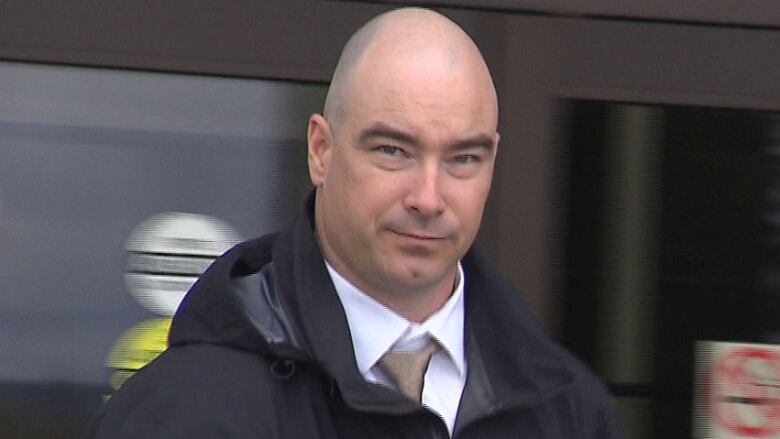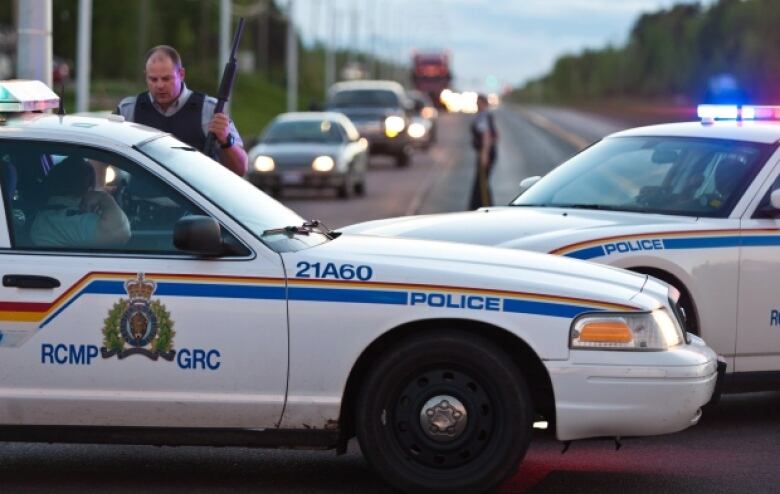Carbines would have been most effective weapon for RCMP in Moncton shootings, trial hears
National force is charged with violating Canada Labour Code in shooting deaths of 3 officers, wounding of 2

An officer who helped review the RCMP response to a shooting rampage in Monctonthat left three Mounties dead and two wounded on June 4, 2014, testified Tuesday that carbines would have been the most effective weapon for the responding officers that night.
Sgt. Sam Tease, who is an expert in use of force, officer safety and training, said being equipped withthehigh-powered,short-barrelledrifles that havea longer and more accurate range than a pistol or shotgun might have made a difference that night.
But it's impossible to say with certainty, he said under cross-examination atthe RCMP's trial in Moncton on Canada Labour Code charges related to the tragedy.
The officers could have acted differently with carbines, but whether they would have,"I don't know what they would have done," he said.
The national police force is charged with violating four provisions of the Labour Codeby allegedly failing to provide members with appropriate use-of-force equipmentand trainingfor responding to an active threat or active shooting event, and failing to ensurethe health and safety of every person employed by the force.
Teasewas part of the team led by retired commissionerAlphonseMacNeilthat produced a 2015 report recommending that officers be equipped with patrol carbines.
The report made 64 recommendations after findingtheMonctonRCMPofficers who responded to the shootings were armed only with shotguns and pistols, which were no match for JustinBourque, who was armed with anM305.308 semi-automatic rifle and aMossberg500 12-gauge shotgun.
No carbines were available to the officers on the night of the shootings,the trial has heard.
Meanwhile, the long guns that were available had not been serviced in years and were unfit to be used, said Tease.
Tactical disadvantage
Staff Sgt. David Lowry, who also participated in the MacNeil report and testified Tuesday, also expressed concerns about the officers' lack of fire power.
It put them at a tactical disadvantage, said Lowry, who worked in labour relations for the RCMP in Ottawa and now acts as a convoy between training teams and policy centres. He alsopreviously served in the military and was deployed to Bosnia as a peacekeeper with the United Nations.
Servicing of a firearm is a key element in its reliability and accuracy, said Lowry. If it's not properly maintained, it can "erode member confidence," he said.

"No two situations are ever going to be the same," the officer said.
He acknowledged it's difficult to speculate how officers would have responded with carbines because everything happened so quickly.
Bourquecould have also acted differently had officers had visible carbines, said Tease.
- On mobile? Follow our live coverage here
Tease, who helped review the operational response to the shootings, based on a timeline and summation of the events, 911 dispatch recordings and a short video, saidsome of the actions of the first responderswere positive and consistent with their training.
They gathered information, communicated with each other, called for backup and called in dog services, he said.
Their containment plan was also appropriate, given the suspect had long guns and was dressed in camouflage, said Tease. Although police didn't initially know Bourque's intentions, incidents involving firearms are considered very high risk, he said.
Concerns about lack of shotguns, body armour
Tease expressed concerns that none of the officers responded to the call withshotguns.
Although some of the previous witnesses said shotguns would have been too dangerous to use, due to their unreliable spread pattern and the risk for civilian casualties in the residential area of the city's north end, Tease testified they could have been useful when Bourque entered the woods.
A shotguncan be effective from a distance of 30 to 40 metres, he said, and the firing range can be extended with different ammunition, he said.
"It does have stopping power."

Tease said the armour is one-size-fits all and the officers could have familiarized themselves with putting it on, even without training.
And while it's possible to put the armour on backwards, the ceramic plates are the same in the front and back, he said.
The officers did, however, take cover to protect themselves from the threat, said Tease.
It's very hard to defend ourselves from an ambush.- Sam Tease, RCMP sergeant
Const. Martine Benot, whose vehicle stopped working after being shot-up by Bourque, for example, crouched behind the engine block, he said.
And the correct positioning of Cpl. DarleneGoguen's vehicle could have been what saved her life after she got shot in the head and managed to drive herself away from the scene, he said.
Const. Doug Larche was ambushed, said Tease.
"It's very hard to defend ourselves from an ambush."
He suggested Const. Erik White, who wound up face to face with Bourque,should not have pursued him alone.
But he also noted the officers lost contact for a short period of time and there was some confusion about where people were.
Bourqueis serving five life sentences with no chance of parole for 75 years after pleading guilty to three counts of first-degree murder and two counts of attempted murder.
Two months have been set aside for the Labour Codetrial, which started April 24.
It is scheduled to resume on Wednesday morning with testimony from retired assistant commissioner Alphonse MacNeil.
With files from Tori Weldon












_(720p).jpg)


 OFFICIAL HD MUSIC VIDEO.jpg)
.jpg)



























































































